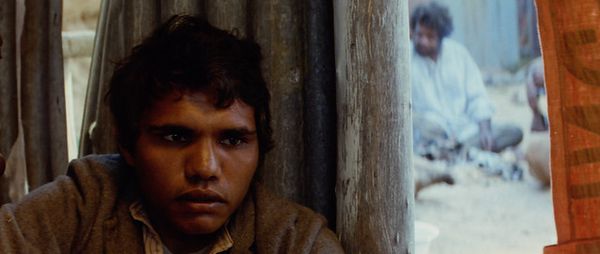Eye For Film >> Movies >> The Chant Of Jimmie Blacksmith (1978) Film Review

Physical boundary fences run through The Chant Of Jimmie Blacksmith - from the one that initially provides its protagonist (Tom Lewis) with a means of employment and that leads to early conflict with his white boss through others belonging to different landowners to the one that he and his brother Mort (Freddy Reynolds in what would sadly be his only film role) climb along in a bid to cover their tracks after the story has become one of vengeance. It's an appropriate symbol for a film that is filled with other, more psychological boundaries - some constructed with protection or containment in mind, others so invisible that the danger isn't apparent until they are crossed.
Fred Schepisi's costume drama - based on the novel by Thomas Keneally which was, in turn, based on the real-life story of Jimmy Governor, who became a notorious criminal - shows that Jimmie himself is a product of a straddled divide between the Aboriginal indigenous population and the white incomers who offer an almost constant sense of threat throughout the film. Born to an Aboriginal mother and white father, his liminal state is emphasised by the Reverend Neville (Jack Thompson) and his wife (Julie Dawson), who take him into their squared off home, which like every European-Australian dwelling here, is packed with possessions, in a bid to emphasise his 'white' characteristics.

Educated to the point at which he views his Aboriginal heritage as something he has largely left behind, Jimmie dreams of being able to put up fence posts around territory of his own but, though Schepisi's film is of the slow-burn variety initially, the writer/director makes us acutely aware of the simmering cocktail of greed, fear and pure racism of the non-indigenous population that make every encounter. Jimmie has with them pregnant with the potential for violence. Set as Australia was on the cusp of creating its federation in 1901, white dividing lines are also evident in the tensions between the European whites calling the population to join their foreign Boer War and Australian-born whites who don't see it as their fight.
The closer Jimmie gets to the boundaries constructed by the whites, including marriage to a white girl, Gilda, he believes is having his child (Angela Punch McGregor, in a small but well worked role), the more they perceive him as a threat and the more we realise violence is brewing. Jimmie is, indeed, becoming a product of white expectations but they are steeping him, not in the civilisation they imagine but in a stew of distrust, threat and resentment.
When the moment of violence arrives, abruptly, at the half-way point, it does so in flurry of handheld camerawork, striking sound design and stark symbolism that sees virginal linen and milk spattered with red and eggs smashed to the floor. The content of the scene, remarkably you might think, led to it being banned as a Section 3 'video nasty' in the UK in the 1980s. The horror, in fact - and something which Schepisi repeatedly refers to in various DVD/Blu-ray extras as "anti-violent violence" - largely stems not from the blood that is spilt but from the psychological implications of us seeing the guy we are rooting for (Jimmie) turn on those that, despite being largely unpleasant, might be considered 'innocent' on some level.
The second half of the film concerns itself with the manhunt for Jimmie and Mort - and their encounter with a more liberal-minded teacher (Peter Carroll). But it's the way that Schepisi digs around in the mire of white attitudes that really holds the interest and which was, as Australian critic Alexandra Heller-Nicholas points out in one of the commentary tracks on the new Eureka Masters of Cinema edition of the film, sharply challenging to her countrymen and women at the time of release and, unfortunately, continues to have strong relevance today. Though robust and critical, this is a "white lens" and the film would make a great double-bill with Warwick Thornton's Sweet Country for those seeking an alternative perspective in a similar narrative setting.
The episodic nature of the film means that despite its painterly lensing from cinematographer Ian Baker, it threatens to lose its momentum in places, though the raw energy of Lewis and Reynolds just about keep things on track. Schepisi is a master craftsman, however, when it comes to key moments - whether it's capturing the blown cigar smoke from sadistic constable Farrell (Ray Barrett, full of brewed menace), chilling conversations between a customer and a butcher, who is also an executioner by trade, all to the sound and sight of chopping meat, or the subconscious half-dance Jimmie makes when his child is born, a boot (a bone of contention with his white employers) twisting in his hand. By the end, even 40 years later, you're likely to be left thinking about the fences that continue to exist, those that sit on them and what still needs to be done to dismantle them.
Reviewed on: 21 Aug 2019
















